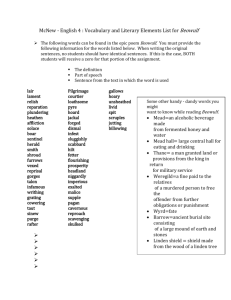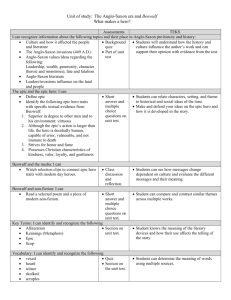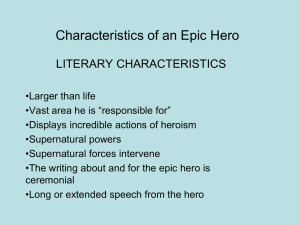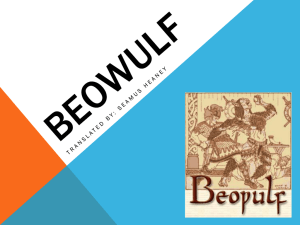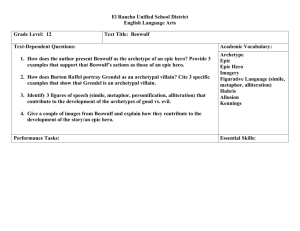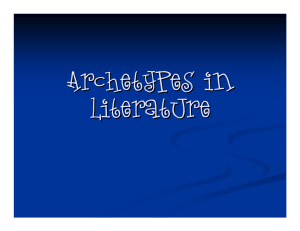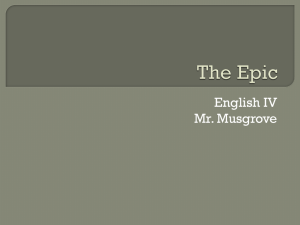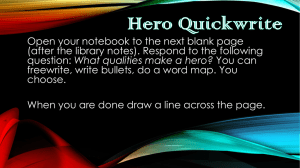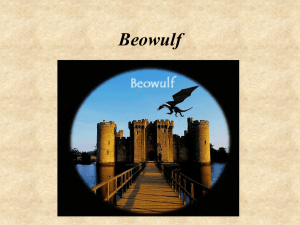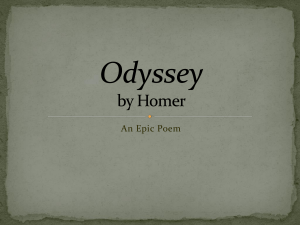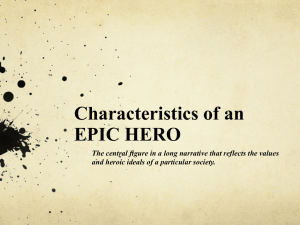The Epic - Sanderson High School
advertisement
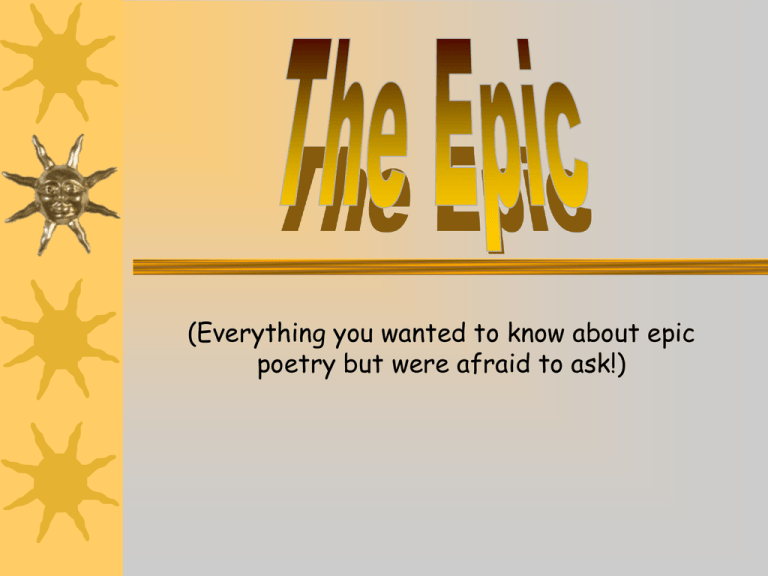
(Everything you wanted to know about epic poetry but were afraid to ask!) The Epic A long, narrative poem told in an exalted style (grand manner) that tells of the exploits and adventures of a hero Oral Tradition – the way a culture passed on its history, legends, myths, and stories from one generation to the next – essential means of archiving history before printing and mass media – often includes rhythm, rhyme, and repetition The Epic Significant to a particular race or culture-- part of a given culture’s history and mythology Often based in literal truth Reveal that culture’s value and belief systems and character Certain elements may be universal, transcending cultural, geographical, and historical boundaries Beowulf as Epic: Anglo-Saxon Scops Professional tribal poets Celebrated cultural values by singing epics on occasions of great ceremony and festivity Presented the stories, legends, myths, values, belief systems, and histories of the AngloSaxon culture Passed them down from one generation to the next Beowulf as Epic: Scops Fulfilled many roles in an Anglo Saxon tribe: • • • • • • • • court singer tribal historian genealogist teacher composer critic warrior traveler and reporter Beowulf as Epic Cultural values embodied in Beowulf: – Loyalty – Valor (courage, bravery) – Selflessness (willingness to sacrifice self for the good of the people) – Justice Beowulf as Epic Prevailing philosophies & religious beliefs evident in Beowulf: – Uneasy mix of Christian and pagan elements (images, symbols, beliefs) – Incl. fatalism: a belief that humans are not in control of their own destinies; Fate is. Archetypes Universal symbols that transcend boundaries of culture, time and geography Part of humanity’s collective unconscious (Carl Jung) Examples include certain-• Images (sun, water, circle, tree, serpent, garden, desert) • Colors (red, green, blue, white, black) • Numbers (3, 4, 7) • Character types (The Good Mother, The Wise Old Man, The Hero) Archetypes--Sun Sun (fire and sky) – – – – creative energy consciousness father principle passage of time and life Rising sun – birth; creation; enlightenment Setting sun – death Archetypes--Water Mysteries of creation Birth-death-resurrection cycles Purification and redemption Sea – mother of all life – timelessness and eternity River – death and rebirth (baptism) – transitional phases of the life cycle Archetypes--Colors Red: blood, sacrifice, violent passion; disorder Green: (Positive) growth; hope; fertility; (Negative) death and decay Blue: highly positive, associated with truth, religious feeling, security, spiritual purity Black: (darkness) chaos, mystery, the unknown; death; the unconscious White: (Positive) light, purity, innocence; timelessness; (Negative) death, terror, emptiness, blinding truth of mystery Archetypes--Circle Circle (Sphere): wholeness, unity Egg (oval): the mystery of life and forces of generation Wheel--symbol of fortune, fate Yang-Yin: a Chinese symbol; represents the union of opposite forces--(Jungian theory of anima and animus) – Yang: masculine principle; light; activity; the conscious mind – Yin: female principle; darkness; passivity; the unconscious More Archetypal Images Serpent • The Garden Evil • Paradise Corruption Sensuality • Innocence Destruction • Unspoiled beauty The unconscious • Fertility More Archetypal Images Desert Spiritual aridity (dryness) Emptiness Hopelessness (Wasteland) Tree Life; consistence and growth Proliferation Immortality; generation and regeneration Archetypes--Numbers Three (3) Spiritual awareness and unity – Example: the Holy Trinity Male principle Four (4) Associated with circle and earth (four corners) Life cycle (four seasons) Female principle Seven (7): Most potent of all symbolic numbers Union of 3 & 4 Completion of a cycle; perfect order Archetypes--Character Types The Good Mother (positive qualities of E.M.) associated with life principle represents birth, warmth, nourishment represents protection and abundance Examples: – – – – – – Mother Nature--the earth mother Demeter/Ceres Marmie March (from Little Women) Captain Planet--Gaia Cinderella--Fairy godmother Star Wars--Anakin Skywalker’s mother(?) Archetypes--Character Types The Terrible Mother (negative qualities of E.M.) femme fatale witch, sorceress, siren, whore, seductress associated with fear, sensuality, danger, darkness, emasculation, death Examples: Delilah – – – – Cinderella--evil stepmother Hera any soap opera The Little Mermaid--Ursula Archetypes--Character Types The Soul Mate Sophia figure--associated with spiritual wisdom Holy mother Princess or “beautiful lady” Incarnation of inspiration and spiritual fulfillment Jungian anima (completion) Examples: – Wizard of Oz--Glenda the Good Witch – Star Wars--Princess Leia – Blue woman (Diva) in The Fifth Element Archetypes--Character Types The Wise Old Man savior, redeemer, guru figure personification of the spiritual principle represents knowledge, reflection, insight, wisdom, cleverness and intuition also represents moral qualities such as goodwill, readiness to help the sagacious and helpful old man Examples: Obiwan Kenobi, Yoda, Merlin, Gandolf, Mr. Miyagi, Splinter, Rafiki, Teiresius Archetypes--Character Types The Hero Archetypes (archetypes of transformation and redemption) Hero’s Initiation (from ignorance and immaturity to social and spiritual adulthood) – Separation – Transformation – Return Examples: Huck Finn, The Lion King, Luke Skywalker, Ebeneezer Scrooge, Overboard, The Prodigal Son Archetypes--Character Types The Sacrificial Scapegoat the hero with whom the welfare of the tribe or nation is identified must die to atone for the people’s sins and to restore the land to fruitfulness Examples: Braveheart--William Wallace, Jesus, Maximus of Gladiator, Somersby, Bruce Willis’ character in Armageddon The Hero Archetype The Hero’s Quest – Undertakes a long journey – Must perform impossible tasks and overcome insurmountable obstacles – Has an important goal to achieve – Is often a savior, deliverer figure Other Archetypal Motifs Creation Immortality Battle of Good v. Evil

